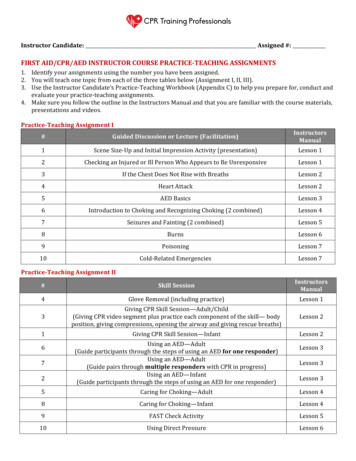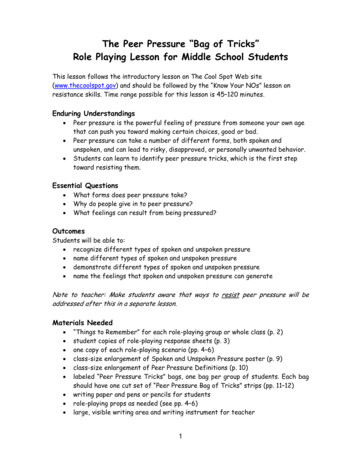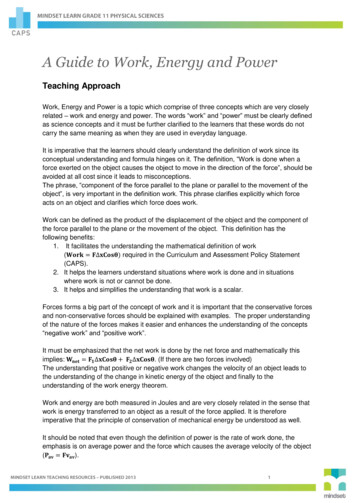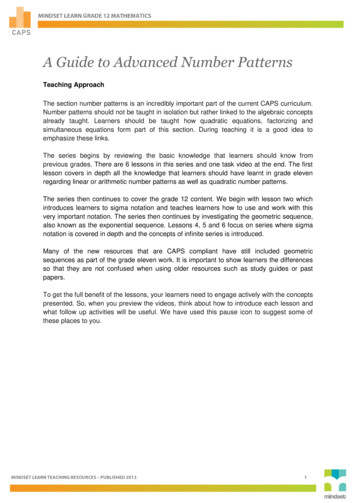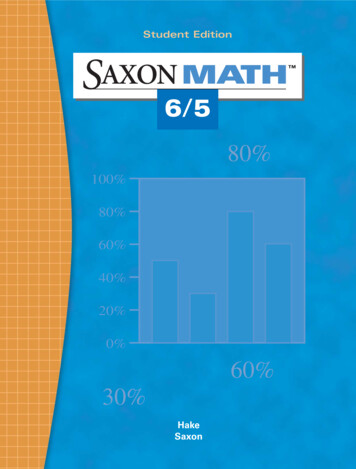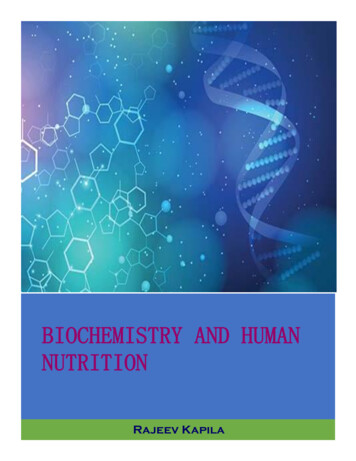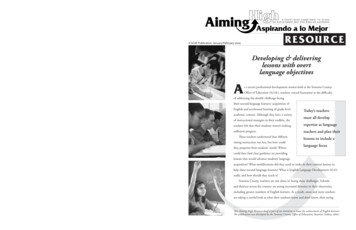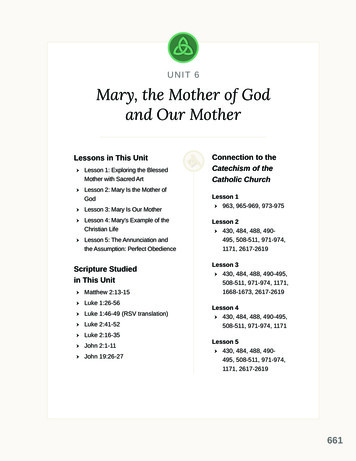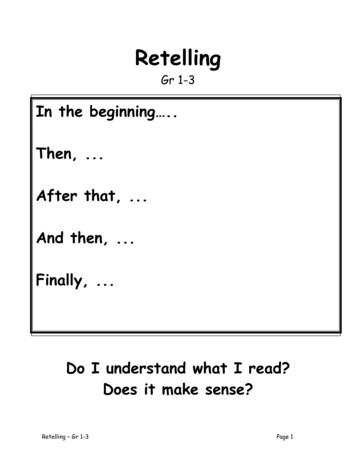
Transcription
RetellingGr 1-3In the beginning .Then, .After that, .And then, .Finally, .Do I understand what I read?Does it make sense?Retelling – Gr 1-3Page 1
Unit of Study: RetellingGrade:Prior Knowledge:What is schema?PretellingDefinitionReaders have two jobs. One is to figure out thewords and the other is to think about what theyare reading. Retelling is a strategy readers useto think about what they are reading. When weretell a story, we tell the important parts, in theright order. This helps us to understand thestory better and remember it longer. Goodreaders stop and retell throughout the text tohelp them understand the story.1. Pretelling2. What is retelling?3. What is the structure of a fictional text?4. Elements of story5. How do good readers stop and think aboutimportant elements of a story?6. Activating schema in retelling7. Using picture walks to help retell8. Retelling with props or pictures9. Focusing on elements in a retelling10. Sequence11. Complete sequential retelling12. Using a retelling guide13. Good readers stop and retell throughout atext14. Retelling in partners (1)15. Retelling in partners (2)16. Retelling without pictures17. Retelling longer texts18. Giving book talksWhat prior knowledge about comprehension dostudents need to have before entering this Unitof Study?What is retelling?Concepts to TeachWhat are the important concepts that you willteach within this Unit of Study?Retelling – Gr 1-3Page 2
Unit of Study: RetellingAnchor LessonsGrade:Text1. Pretelling2. What is retelling?3. What is the structure of afictional text?4. Elements of storyKey ConceptsClassroom routinesClassroom discussionFictional text with clearcharacters, problem andsolution. Pete’s a PizzaPete’s a Pizza Forward thinkingDefinition of retellingStructure of fiction Demonstrate the elements ofa storyReaders stop and notice theelements as they read5. How do good readers stop andthink about important elements ofa story?6. Activating schema in retellingCat on a Mat Five Little Monkeys 7. Using picture walks to helpretellAny of the texts used inprevious lessons (4-6) 8. Retelling with props or picturesAny of the texts used inprevious lessons (4-6) 9. Focusing on elements in aretelling 10. SequenceCookie’s Week (setting)The Mitten (characters)One Windy Wednesday(problem/solution) Any of the texts from lesson 911. Complete sequential retelling Any of the texts from lesson 9 12. Using a retelling guide Any of the texts from previouslessons 13. Good readers stop and retellthroughout a text14. Retelling in partners (1)15. Retelling in partners (2)16. Retelling without pictures The Doorbell Rang 17. Retelling longer texts18. Giving book talks IR booksIR booksFrog and Toad Books, Nate theGreatCam JansenIR booksRetelling – Gr 1-3 Readers think about whatthey know about abook/topic/author beforethey begin reading. Thishelps them retell.Readers use pictures to retellthe important elements of astoryReaders use pictures or propsto retell the importantelements and understand thestoryReaders stop and notice theelements as they readReaders retell a story inorder so that it makes senseReaders retell completely andin sequence to understandthe story betterReaders use a retelling guideas a strategy to rememberwhat to include in a complete,sequential retellngReaders stop and retell asthey read. Page 3
Unit of Study: RetellingAnchor ChartsWays to Record ThinkingGraphic Organizers, Post-its,JournalsGrade: Elements of fictionElements of nonfictionStrategies to help us retellRetelling guideBook talk guidelinesPost-itsGraphic organizersPicturesDrawingSmall GroupText/LevelIndependent ReadingConference Points Evidence of Understanding andIndependence(Oral and written)Celebrations of LearningRetelling – Gr 1-3ConceptTell me what is happening in your story so farShow me how you can use the pictures to retell your storyWhat do you know about this book/topic/author?Show me how you can skim the page to retell the storyShow me how you can reread to clarify your retellingWhat strategies are you using to help you retell your book?Can you tell me about the (element) in your story?Turn and Talk ConversationsOral retellings with partnersOral book talksWritten retellingsBook recommendationsBook talksDrama –act out storiesPage 4
Unit of Study: RetellingRecommended Model Text for RetellingAny text with clear episodes (plot)TitleAuthorNotesThe MittenJan Brett(all of her books)The Doorbell RangPat HutchinsTidy TitchPat HutchinsPete’s a PizzaWilliam SteigCat on a MatKen WilsonFive Monkeys JumpingCookie’s WeekTomie de PaolaOne Windy WednesdaySnowy DayEzra Jack KeatsCarrot SeedLeo the Late BloomerNursery RhymesFairy TalesThe HatJan BrettGeorge and Martha BooksJames MarshallMarshall Fairy TalesJames MarshallFox SeriesJames MarshallRetelling – Gr 1-3Page 5
Unit of Study: RetellingAnchor Lesson: 1. PretellingTitle of TextLesson PlanSelect thematerialsName theStrategy.Explain.Familiar routines or activities in theclassroom.“I have noticed that ”“A strategy readersuse is ”Pretelling involves students consciouslythinking through familiar routines andactivities by identifying the steps involvedand then recounting those steps. Threebasic steps will help students to thinkforward: (1) identifying the steps involvedin an activity as they participate in theactivity; (2) recalling the steps frombeginning to end; and (3) organizing thosesteps into written form.Notes to Build NextLessonThis definition is forTeachers NOT forstudents.In choosing an activity or routine for theinitial pretelling sessions, be sure to chooseone in which students can participate in theclassroom while they identify steps.Retelling – Gr 1-3Page 6
Unit of Study: RetellingAnchor Lesson: 1. PretellingDemonstrate theStrategy.Say: Think aloud.Show: Model.Explain: How this willhelp them as areader.Today I am going to show you how I changethe books in my IR bag. I am going topretell the steps that I go through inchanging my books. That means that I amgoing to say the steps out loud while I amchanging the books.The first thing that I do when I change mybooks is take them all out of my bag. (Takethem out)First, I look through the books and decidewhich books I am an expert with and whichbooks I need more practice with.Then, I sort them into two piles (need morepractice and trade) (Make the piles)After that, I put the need more practicebooks back into my bag. Next, I trade theother books for new books from a basketthat makes me feel strong as a reader.Finally, I put all the books into my bag.(Model all these steps)Model how to recall the steps by pointing tothe concrete objects used in the activitywhile reviewing the steps.Now , what did I just do to change thebooks in my bag. Let me think about eachstep (Retell the steps)Write the steps of the routine on a chart.Use of time order words is essential. Readthe chart with the students.Provide guidedpracticeHave the students read the chart with youseveral times.Invite the studentsto practice thestrategy withteacher guidance.Retelling – Gr 1-3Page 7
Unit of Study: RetellingAnchor Lesson: 1. PretellingProvideIndependentpracticeStudents can think of other routines topretell in class. Have students practiceretelling these routines.Remind studentsbefore they go off toread “When you goto IR try ”ConferencePointsShare/reinforceRetelling – Gr 1-3Page 8
Unit of Study: RetellingAnchor Lesson: 2. What is retelling?Title of TextLesson PlanSelect the materialsName the Strategy.Explain.Classroom discussion“I have noticed that ”“A strategy readers use is ”Demonstrate theStrategy.Say: Think aloud.Show: Model.Explain: How this will helpthem as a reader.Provide guided practiceInvite the students topractice the strategy withteacher guidance.Provide IndependentpracticeRemind students before theygo off to read “When yougo to IR try ”Retelling – Gr 1-3Notes to Build NextLessonReaders have two jobs. One is tofigure out the words and the otheris to think about what they arereading. Retelling is a strategyreaders use to think about whatthey are reading. When we retell astory, we tell the important parts,in the right order. This helps us tounderstand the story better andremember it longer. Strongreaders stop and retell throughoutthe text to help them understandthe story.Role-play by taking a bag to a spotand by modeling how you might usethe pictures to read the story, orto recall a familiar line.Show students that when you finishreading books, you will stop andthink about the story. You may lookat the pictures again and tellyourself what happened.What did you notice about how Iread my books?What will you try today during IR?Today at IR I want you to thinkabout taking your books out of yourbag and beginning to read them.Stop and think about what ishappening in your books. When wecome back together I will want tohear about a book you enjoyedtoday, so think about that while youare reading.Page 9
Unit of Study: RetellingAnchor Lesson: 2. What is retelling?Conference PointsShare/reinforceRetelling – Gr 1-3May I hear you read a section?Are you enjoying this book? Tell me what is happening inyour book so far.Who has a book they would like toshare with the class? Page 10
Unit of Study: RetellingAnchor Lesson: 3. What is the structure of a fictional text?Title of TextLesson Plan:Select the materialsPete’s a PizzaName the Strategy.Explain.We have been talking about howreaders have two jobs. One is tofigure out the words and the otheris to think about what they arereading. Retelling is a strategyreaders use to think about whatthey are reading. While we learnabout the strategy of retelling weare going to be reading fictionbooks. Fiction books are storiesthat are not true or imaginary.When we read fiction we thinkabout what is going to happen in thestory.Choose a text that supportsthe strategy.“I have noticed that ”“A strategy readers use is ”Introduce the Text.Demonstrate theStrategy.Say: Think aloud.Show: Model.Explain: How this will helpthem as a readerRetelling – Gr 1-3Notes to Build NextLessonThis book, Pete’s a Pizza, is a fictionbook. It will have characters,setting, a problem and a solution.Before I begin to read this book, Iam going to think about what Ithink is going to happen. The titleis Pete’s a Pizza. I think this boyPete will be a character and he isgoing to eat some pizza.As I read the story, I am going tostop and think about what I amreading and about what is happeningin the story.Oh, Pete does not eat pizza; hisparents make him into a pizza tocheer him up.Page 11
Unit of Study: RetellingAnchor Lesson: 3. What is the structure of a fictional text?Provide guided practiceTurn and talk with a partner aboutsomething you remember in Pete’s aPizza.Provide IndependentpracticeToday at IR, you will all have fictionbooks in your bag. Stop and thinkabout what is happening in yourbooks as you read.Invite the students topractice the strategy withteacher guidance.Remind students before theygo off to read “When yougo to IR try ”Conference PointsShare/reinforceRetelling – Gr 1-3May I hear you read a section?Are you enjoying this book?Tell me what is happening inyour book.Who has a book they would like toshare with the class? Why did youchoose to share that book? Page 12
Unit of Study: RetellingAnchor Lesson: 4. Elements of StoryTitle of TextLesson Plan:Select the materialsName the Strategy.Explain.Pete’s a Pizza“I have noticed that ”“A strategy readers use is ”Introduce the Text.Demonstrate theStrategy.Say: Think aloud.Show: Model.Explain: How this will helpthem as a reader.Notes to Build NextLessonWe have been talking about howreaders have two jobs. One is tofigure out the words and theother is to think about what theyare reading. Retelling is astrategy readers use to thinkabout what they are reading.Retelling includes the elements ofa story. We are going to readPete’s a Pizza again today.While we learn about thestrategy of retelling we are goingto be reading fiction books.Fiction books are stories that arenot true or imaginary. When weread fiction we think about whatis going to happen in the story.Fiction books have the elementsof character, setting, problemand solution.As I read Pete’s a Pizza today, Iam going to stop and point out theelements that are in this story. Iwill look to find the characters,setting, problem and solution.Read aloud the story and stop andnote the elements as you read.Think aloud how you know it is theelement. For example, thesetting is the house I know thisbecause that is where the storytakes place.Thinking about the elements willhelp me remember the story so Ican retell it completely.Retelling – Gr 1-3Page 13
Unit of Study: RetellingAnchor Lesson: 4. Elements of StoryProvide guided practiceHave students recall theelements of a fictional text.Provide IndependentpracticeToday at IR, you will all havefiction books in your bag. Stopand think about what is happeningin your books as you read.Invite the students topractice the strategy withteacher guidance.Remind students before theygo off to read “When yougo to IR try ”Conference PointsShare/reinforceRetelling – Gr 1-3May I hear you read asection? Are you enjoying this book? Tell me what is happening inyour book.Who has a book they would like toshare with the class? Page 14
Unit of Study: RetellingAnchor Lesson: 5. How do good readers stop and think about importantelements in a story?Title of TextLesson Plan:Select the materialsName the Strategy.Explain.Cat on a Mat“I have noticed that ”“A strategy readers use is ”Introduce the Text.Demonstrate theStrategy.Say: Think aloud.Show: Model.Explain: How this will helpthem as a reader.Notes to Build NextLessonWe have been talking about howreaders have two jobs. One is tofigure out the words and the otheris to think about what they arereading. Retelling is a strategyreaders use to think about whatthey are reading. Good readersstop and think about the importantelements as they read.Cat on the Mat is a fiction story.As I read Cat on a Mat, I am goingto stop and think about theelements that are in this story. Iwill stop and think about thecharacters, setting, problem andsolution.Read aloud the story and stop andnote the elements as you read.Think aloud how you know it is theelement. For example, the settingis on the rug. I know this becausethat is where the story takes place.Thinking about the elements willhelp me remember the story so Ican retell it completely.Provide guided practiceHave students recall the elementsof a fictional text.Provide IndependentpracticeToday at IR, you will all have fictionbooks in your bag. Stop and thinkabout what is happening in yourbooks as you read.Invite the students topractice the strategy withteacher guidance.Remind students before theygo off to read “When yougo to IR try ”Retelling – Gr 1-3Page 15
Unit of Study: RetellingAnchor Lesson: 5. How do good readers stop and think about importantelements in a story?Conference PointsShare/reinforceRetelling – Gr 1-3May I hear you read a section?Are you enjoying this book?Tell me what is happening inyour book.Did anyone notice an element in oneof your books today? Page 16
Unit of Study: RetellingAnchor Lesson: 6. Activating Schema in retellingTitle of TextLesson Plan:Select the materialsName the Strategy.Explain.Five Little Monkeys“I have noticed that ”“A strategy readers use is ”Retelling – Gr 1-3Notes to Build NextLessonSchema is a reader’s backgroundknowledge that is used tounderstand the text. Good readersuse their schema to think about thetopic of a book and to understandthe characters and the plot. Whenyou think about what you know andhow the book is the same ordifferent, it will help you remembermore when you retell the book.Page 17
Unit of Study: RetellingAnchor Lesson: 6. Activating Schema in retellingDemonstrate theStrategy.Say: Think aloud.Show: Model.Explain: How this will helpthem as a reader.Watch how I use my schema beforeI read a book. This book, FiveLittle Monkeys, is about a song Iknow – Five Little Monkeys Jumpingon the Bed. I know that song isabout five monkeys who jump on thebed and bump their heads. I know alot about the topic of this book, sowhile I am reading it I will noticethings that will help me rememberthe story.Read the book. Stop and thinkaloud where your schema for thesong matches the book.There are the monkeys and themother. One is jumping on the bedand falls off. That is what happensin the song. The characters are thesame. This will help me rememberthe characters when I retell thestory.Continue to think aloud. After thesecond or third example, tell themto think about what they knowabout a book before they beginreading it.When you think about your schemabefore you read, it helps youremember when you retell the book.Provide guided practiceInvite the students topractice the strategy withteacher guidance.Retelling – Gr 1-3Turn and talk with a partner aboutyour schema for the Five LittleMonkeys and how it helped youretell the book.Page 18
Unit of Study: RetellingAnchor Lesson: 6. Activating Schema in retellingProvide IndependentpracticeRemind students before theygo off to read “When yougo to IR try ”Conference PointsShare/reinforceRetelling – Gr 1-3Before you begin reading today,take a few minutes to think aboutyour schema for the topic of yourbook. Then read the book. As youare reading think about how yourschema is helping you to rememberthe elements of story when youretell it. May I hear you read a section? Are you enjoying this book? Tell me what is happening in thestory right now. Retell what you have read sofar. What was your schema for thisbook? How is your schema helping youunderstand the story? How is your schema helping youretell the story?Who would like to share how theyused their schema to help themremember their book?Page 19
Unit of Study: RetellingAnchor Lesson: 7. Using picture walks to help retellTitle of TextLesson Plan:Select the materialsName the Strategy.Explain.Any texts used in lessons (4-6)“I have noticed that ”“A strategy readers use is ”Demonstrate theStrategy.Say: Think aloud.Show: Model.Explain: How this will helpthem as a reader.Notes to Build NextLessonSchema is a reader’s backgroundknowledge that is used tounderstand the text. Good readersuse their schema to think about thetopic of a book and to understandthe characters and the plot.Readers often take a picture walkto help them gain information aboutthe story before they read it.Watch how I take a picture walk ofthis book before I read it to gaininformation about the book.Model a picture walk. Stop andthink aloud what you noticing aboutthe story.On this page there is a cat on amat. Oh on this page the dog isgetting on too. Oh, at the end ofthe story the cat looks mad and allthe animals run away.When you gain information about abook before you read it, it helpsyou remember the importantelements when you retell the book.Provide guided practiceHave students turn and take apicture walk with an IR book.Provide IndependentpracticeToday at IR, remember to do apicture walk with your book so youcan retell the story and include theimportant elements.Invite the students topractice the strategy withteacher guidance.Remind students before theygo off to read “When yougo to IR try ”Retelling – Gr 1-3Page 20
Unit of Study: RetellingAnchor Lesson: 7. Using picture walks to help retellConference PointsShare/reinforceRetelling – Gr 1-3May I hear you read a section?Are you enjoying this book?Tell me what is happening in thestory right now. Retell what you have read sofar. What was your schema for thisbook? How is your schema helping youunderstand the story? How is your schema helping youretell the story? Show me how you take a picturewalk.How did your picture walk help youretell your story?Who wants to share a picture walkwith us and tell us how it helped youretell the story? Page 21
Unit of Study: RetellingAnchor Lesson: 8. Retelling with props or picturesTitle of TextLesson Plan:Select the materialsAny of the texts from previouslessons (4-6)Name the Strategy.Explain.“I have noticed that ”“A strategy readers use is ”Demonstrate theStrategy.Say: Think aloud.Show: Model.Explain: How this will helpthem as a reader.Notes to Build NextLessonReaders have two jobs. One is tofigure out the words and the otheris to think about what they arereading. Retelling is a strategyreaders use to think about whatthey are reading. When we retell astory, we tell the important parts,in the right order. This helps us tounderstand the story better andremember it longer. Good readerssometimes use the pictures orprops to help them retell a book.Choose a familiar book that youhave props for or photocopy thepictures of a book to use in aretelling.Retell the story using the props.The retelling should include the allthe elements and should be insequential order. Use time orderwords in your retelling.I am going to retell the story FiveLittle Monkeys using these monkeysand this picture of a bed. Watchme retell the story.Provide guided practiceInvite the students topractice the strategy withteacher guidance.Retelling – Gr 1-3Act out the story and then have thestudents help you retell the story asecond time.Have students participate inretelling the story with props afteryou model it once.Page 22
Unit of Study: RetellingAnchor Lesson: 8. Retelling with props or picturesProvide IndependentpracticeRemind students before theygo off to read “When yougo to IR try ”Conference PointsShare/reinforceRetelling – Gr 1-3Today during IR, I have put outsome books we have read with someprops for the story. You can workwith a partner to use the props toretell the story. Remember toinclude the elements in yourretelling. Show me how you used theprops to retell the story.Who would like to use the props toretell a book to the class?Page 23
Unit of Study: RetellingAnchor Lesson: 9. Focusing on elements in a storyTitle of TextLesson Plan:Select the materialsName the Strategy.Explain.The Mitten By Jan Brett“I have noticed that ”Good readers notice that storieshave different elements (parts).When you retell a story it isimportant to know and include thecharacters.“A strategy readers use is ”Demonstrate theStrategy.Say: Think aloud.Show: Model.Explain: How this will helpthem as a reader.Watch me read this story andnotice the characters. I can usethe pictures and the words tohelp me.Notes to Build NextLessonThis same lesson would berepeated for setting, problemand solution using differenttext. Isolate one element at atime. Once students arecomfortable with one element,add the others. Have them tryto notice one at a time beforeyou have them begin to noticethem all.Read text and model how younotice and remember thecharacters.This little boy is on the cover andon the first page. His name isNikki – he is going to beimportant to the story so I willremember him. I will close myeyes and picture him and his nameso I can remember him.Continue to model how you noticeand remember the characters.Knowing the characters will helpyou retell and understand thestory.Provide guided practiceInvite the students topractice the strategy withteacher guidance.Retelling – Gr 1-3Ask students to tell thestrategies they noticed you usingto identify and remember thecharacters.Page 24
Unit of Study: RetellingAnchor Lesson: 9. Focusing on elements in a storyProvide IndependentpracticeConference PointsToday when you go off to IR,remember to stop and notice whothe characters are in the story.If they are important to thestory, stop and think about howyou will remember them. May I hear you read asection? Are you enjoying this book? Share/reinforceRetelling – Gr 1-3Retell what you have read sofar. Tell me what is happening inthe story right now. Who are the characters inyour book?Who would like to tell us about acharacter in your book? How didyou notice and remember thatcharacter?Page 25
Unit of Study: RetellingAnchor Lesson: 10. SequenceTitle of TextLesson Plan:Select the materialsName the Strategy.Explain.Goldilocks and the Three Bears“I have noticed that ”“A strategy readers use is ”Retelling – Gr 1-3Notes to Build NextLessonReaders have two jobs. One is tofigure out the words and the otheris to think about what they arereading. Retelling is a strategyreaders use to think about whatthey are reading. When we retell astory, we tell the important parts,in the right order. This helps us tounderstand the story better andremember it longer.Page 26
Unit of Study: RetellingAnchor Lesson: 10. SequenceDemonstrate theStrategy.Say: Think aloud.Show: Model.Explain: How this will helpthem as a reader.I have noticed that sometimesretellings are not in sequence. I amhearing retellings that include thebeginning and the end, but themiddle parts are not in the correctorder. This is an example of aretelling that is not in sequence:The Three Bears decided to go fora walk while the porridge wascooling off. Goldilocks came in thehouse. She went to bed and fellasleep. The bears came home andfound her. She ran off.This retelling is not in sequence. Itis difficult to understand the storyif it is retold out of sequence. Asyou read, think about the order ofevents and try to retell them insequence.Watch me use the pictures andskim for information to help meretell the story in sequence.Model a sequential retelling. Thinkaloud how you are remembering theorder and how the pictures arehelping you.When we retell in sequence, it helpsus understand the story andremember it longer.Provide guided practiceInvite the students topractice the strategy withteacher guidance.Retelling – Gr 1-3Have the students turn to a partnerand try to retell Goldilocks insequence.Page 27
Unit of Study: RetellingAnchor Lesson: 10. SequenceProvide IndependentpracticeRemind students before theygo off to read “When yougo to IR try ”Conference PointsShare/reinforceRetelling – Gr 1-3When you go to IR today, try tonotice the events in your story.Notice what is happening in thebeginning, the middle and the end.The sequence is important to thestory. May I hear you read a section? Are you enjoying this book? Retell what you have read sofar. Tell me what is happening in thestory right now. Who are the characters in yourbook? What happened in thebeginning, the middle, the end?Who would like to try to retell thebeginning, middle and end of a bookthey have read?Page 28
Unit of Study: RetellingAnchor Lesson: 11. Complete Sequential RetellingTitle of TextLesson Plan:Select the materialsName the Strategy.Explain.The Three Little Pigs“I have noticed that ”“A strategy readers use is ”Demonstrate thestrategy.Say: Think aloud.Show: Model.Explain: How this will helpthem as a reader.Notes to Build NextLessonReaders have two jobs. One is tofigure out the words and the otheris to think about what they arereading. Retelling is a strategyreaders use to think about whatthey are reading. When we retell astory, we tell the important parts,in the right order. This helps us tounderstand the story better andremember it longer.I have noticed that sometimes theretellings I am hearing from you arelike swiss cheese. They are full ofholes and not in the right order.Retellings need to be in sequenceand include all of the importantevents.Model a swiss cheese retelling ofThe Three Little Pigs. Leave outone of the pig’s houses and leaveout the wolf blowing a house down.Then I can use strategies to help meretell this story so it is completeand in the correct order.Model a complete sequentialretelling. Show the students howto use the pictures and how to skimfor information to make yourretelling stronger.Retelling – Gr 1-3Page 29
Unit of Study: RetellingAnchor Lesson: 11. Complete Sequential RetellingI know there are three pigs so I amgoing to remember I have to includethree houses and three visits fromthe wolf. I can also remember thatthe only house not to fall down isthe brick house, so that houseshould be the last one I include inmy retelling.When we retell completely and inthe proper order it helps us tounderstand the story better andremember it longer.Provide guided practiceInvite the students topractice the strategy withteacher guidance.Provide IndependentpracticeRemind students before theygo off to read “When yougo to IR try ”Conference PointsShare/reinforceRetelling – Gr 1-3Have the students turn to a partnerand try to retell Three Little Pigs insequence.Begin an anchor chart: “Strategiesto Help Us Retell”When you go to IR today, try tonotice the events in your story.Notice what is happening in thebeginning, the middle and the end.The sequence is important to thestory. May I hear you read a section? Are you enjoying this book? Retell what you have read sofar. Tell me what is happening in thestory right now. Who are the characters in yourbook? What happened in thebeginning, the middle, the end?Who would like to try to retell thebeginning, middle and end of a bookthey have read?Page 30
Unit of Study: RetellingAnchor Lesson: 12. Using a retelling guideTitle of TextLesson Plan:Select the materialsName the Strategy.Explain.The Gingerbread Baby Jan Brett“I have noticed that ”“A strategy readers use is ”Retelling – Gr 1-3Notes to Build NextLessonReaders have two jobs. One is tofigure out the words and the otheris to think about what they arereading. Retelling is a strategyreaders use to think about whatthey are reading. When we retell astory, we tell the important parts,in the right order. This helps us tounderstand the story better andremember it longer.Page 31
Unit of Study: RetellingAnchor Lesson: 12. Using a retelling guideDemonstrate theStrategy.Say: Think aloud.Show: Model.Explain: How this will helpthem as a reader.We have read this book many, manytimes together. When I try toretell this book, I can use aretelling guide to help me retell thestory in sequence. This retellingguide helps me use connector wordsto weave our retelling together.Watch me use this
Elements of story Pete’s a Pizza Demonstrate the elements of a story 5. How do good readers stop and think about important elements of a story? Cat on a Mat Readers stop and notice the elements as they read 6. Activating schema in retelling Five Little Monkeys Readers think

